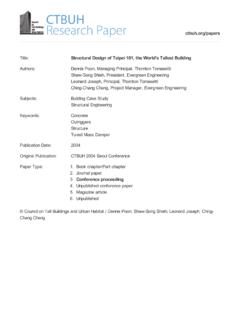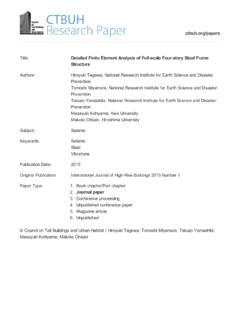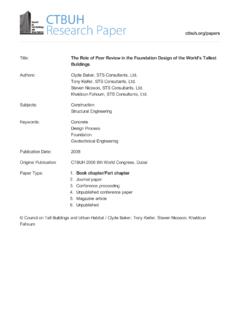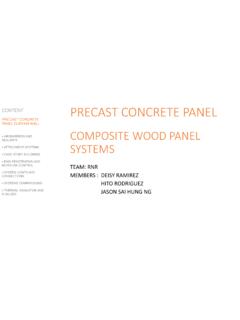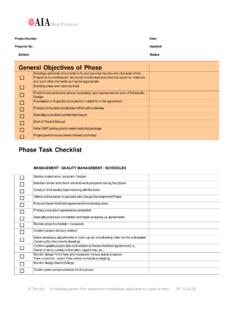Transcription of Shanghai Tower: Building a Green, Vertical City
1 Title: Shanghai Tower: Building a Green, Vertical City in the Heart of ShanghaiAuthor:Jianping Gu, President & Board Director, Shanghai Tower Construction &DevelopmentSubjects:Architectural/Desig nBuilding Case StudyEconomics/FinancialKeywords:Economi csEnvironmentMegatallPublic SpacePublication Date:2015 Original Publication:Asia & Australasia: A Selection of Written Works on the World's Tall BuildingForefrontPaper Type:1. Book chapter/Part chapter2. Journal paper3. Conference proceeding4. Unpublished conference paper5. Magazine article6. Unpublished Council on Tall Buildings and Urban Habitat / Jianping that. Because it incorporates so many advanced techniques based on current skyscrapers, it will be a learning laboratory for the next generation of skyscraper designers. And it illustrates that architecture should not be constructed for its own sake, but for the people, which is the most fundamental factor. Motivation: Built for PeopleTall buildings are often seen as iconic landmarks, which encourages one to take an external view only.
2 But in order to achieve sustainable Vertical urbanism, skyscrapers must turn their focusing point from ROI of human experience to people and specifically the users demands to become enjoyable, even exhilarating Tower provides a vision of vertically integrated space through the signature design of a double fa ade that creates unique sky lobbies, filled with vegetation, offering the potential for socializing, and providing relief from the isolative nature of tall buildings without the necessity of descending to the ground. But why do this? Is this design arrived at arbitrarily, or though assumptions?A typical return on investment (ROI) calculation subtracts the cost of investment from the gain from investment. But when planning buildings as Vertical cities, they must be thought of as systems. Importantly, traditional ROI calculations also overlook the value of human capital the people who occupy the following was published in the main proceedings publication for the CTBUH 2014 Shanghai Conference, Future Cities: Towards Sustainable Vertical Shanghai Tower establishes a new paradigm for tall buildings and Vertical urbanism.
3 Innovation and new technology play a strong role in the superlative aesthetic, structural, and environmental achievements of this disruptive Building , while reinforcing time-honored maxims of design that still hold true. While the distant silhouette and the proximate detail of the tower will be immediately distinctive, the purpose of the Shanghai Tower is not simply to be seen as an iconic landmark. It is much more Shanghai Tower: Building a Green, Vertical City in the Heart of ShanghaiJianping Gu, President & Board Director, Shanghai Tower Construction & Development Co., Ltd. 57 Opposite: Shanghai Tower standing among the World Financial Center and Jin Mao Tower. Source: Gensler Bottom: Tower base at street level. Source: Gensler58 Left: Building section highlighting the different functions. Source: Gensler Opposite: Rendering of the Community Square space. Source: GenslerAn expanded ROI calculation considers that sustainably designed buildings can reduce sick time by two to five days annually and increase productivity by percent.
4 When one is designing a skyscraper to accommodate more than 20,000 people, the value of that productivity increase justifies the extra expense of what we call reinventing the chassis of the high-rise. The biggest distance between the outer curtain wall system and the main structure in Shanghai Tower is 15 meters, which prevents about 20,000 office staff and hotel guests from directly facing the outdoors at an altitude of several hundred meters and eases people s anxieties about extreme heights. The presumable five percent of people who suffer from acrophobia could work calmly in Shanghai Tower. This is another return on design investment that increases s more, 10 times a year, five percent of the people who work in the Tower (about 1,000 people) either need to be in the same places in the city for face-to-face working or activities, and as a result spend at least half an hour in transportation. If they only need several minutes to come together to meet, 5,000 hours of transportation time could be saved, along with the related traffic congestion and pollution caused by automobile : More Than Mere ConstructionsAs modern buildings have become more and more extravagant, the economics are becoming the dominant factors of evaluation, while the interior communication spaces for occupants have been gradually ignored.
5 However, with rapid improvement of financial conditions and living standards, the call to go back to nature, enhance communication, and provide cozy and convenient living space has been amplified, and is consistently inspiring architects to design tall buildings more creatively. Observatory Hotel Office Retail59 Shanghai Tower provides a vision of vertically integrated space through the signature design of a double fa ade that creates unique sky lobbies, filled with vegetation, offering the potential for socializing, and providing relief from the isolative nature of tall buildings without the necessity of descending to the ground. Shanghai Tower has introduced the concepts of Vertical Community, Community Square, and Sky Gardens. The concept of Vertical Community is meant to stack traditional horizontal blocks into nine Vertical communities, each equipped with private space.
6 Community Square is the unique participatory space between the layers of the double-skin fa ades, which are over 10 meters wide. Every community has three sky lobbies, called Community Squares, whose heights range from 50 to 60 meters. The tower has 21 Community Squares in total. They fulfill the requirements of energy efficiency, Vertical circulation, fire defense and life safety, and at the same time provide complementary services of relaxation, social contact, viewing, catering and finance. Vertical Community is reinforced by planting flowers and trees in the Community Square at various heights, and create Vertical greenery. Shanghai Tower has systematically introduced the design of communities, squares, and gardens into skyscrapers, which is a unique feature to tall buildings around the Tower has adopted the design approach of Vertical compound functions. In addition to the traditional shopping mall (Zone 1), office (Zone 2 Zone 6), hotel (Zone 7 Zone 8), and sightseeing (Zone 9) there are additional versatile function blocks.
7 Public museums (37th floor), Galleries, lifestyle centers (B1, 52 floor, 53 floor), fitness facilities (22 floor), art exhibitions, and cultural activities are introduced into the Community Squares, providing fresh life experiences for the people in the : Innovate for SustainabilityBesides fulfilling the requirements of construction Shanghai Tower is also a primary case study of the innovative technologies of external view catches the attention of designers and investors. Shanghai Tower not only presents an elegant form, but 60 Bottom: The tower s double-skin fa ade. Source: Gensler Opposite Top: Model shake test. Source: GenslerOpposite Bottom: The different design considerations determined twisting the tower 120 degrees is the solution. Source: Gensleralso represents significant achievements in structural safety and cost savings. It shows the elegance and fashionable characteristics of Shanghai by twisting the outer enclosure by 120 degrees while spiraling up.
8 Through wind-tunnel tests, its designers determined that we know that the wind load could be reduced 24 percent, which is quite considerable in a city that suffers from typhoons every year, saving 20,000 metric tons of steel in the the complexity of the Building , it was incumbent upon the designers to continue to measure its performance, even as it was being built, with a view toward continuous monitoring after completion. The structural health monitoring (SHM) system helps dynamically observe risks, quality level and structural states under loads, providing safety warnings and information for maintenance and inspection. The SHM monitors seismic response, displacement and settlement, structural temperature, stress and strain, and tower structure Tower has distinguished itself as an exemplary smart Building . The design and construction of Shanghai Tower has been contemporaneous with developments in sophisticated digital technology and major IT advances, such as cloud computing, and, for the first time in commercial buildings, the integration of the Internet of Things, and Building Information Modeling (BIM).
9 The tower s technology consists of a basic support level (cabling system, equipment), a middle layer of 31 intelligent subsystems (fire-alarm and public-address systems, Building Control System for facilities, energy monitoring systems, a one-card security pass system, and an integrated communications system); and a top layer consisting of the Intelligent Building Management System (IBMS), which integrates the collection storage, processing, analysis and display of data from all subsystems). The transmission system for all of this data is Internet-Protocol (IP)-based, and a 10-GB backbone and 1-GB IP network serve 90 percent of the intelligent The objective behind using BIM to design Shanghai Tower was to execute the project by using Lean management techniques and to realize the full life-cycle monitoring concept. To achieve this, Shanghai Tower s design team used Autodesk Vault Professional, a data-management platform that can manage and integrate data from various programs.
10 The client established a working group, involving all the BIM teams from design to construction to material supply, and formed a working framework and standards unified by a clear hierarchy. For example, by using BIM on the external curtain wall, the efficiency of drawing processing maps increased by 200 percent. The conversion efficiency of processing 62map data has increased by 50 percent, while the measurement efficiency of complex components increased by 10 percent. For the MEP disciplines, using the BIM framework cut 60 percent from onsite workloads and allowed pipeline assembly to be 70 percent prefabricated. All told, using BIM cut three to five percent of the total project cost that is normally devoted to post- design changes and human error, while cutting clashes had a value of more than 100 million RMB (US $16 million). The role of BIM technology does not end on Shanghai Tower s opening day. The project team has studied how to apply BIM in the asset management of the tower and continue to use it as part of a Property Asset Operations Platform (PAOP), comprising BIM, Facilities Management (FM) and IBMS : Responsible DevelopmentTall buildings have a significant influence on the urban features and regional environment.
